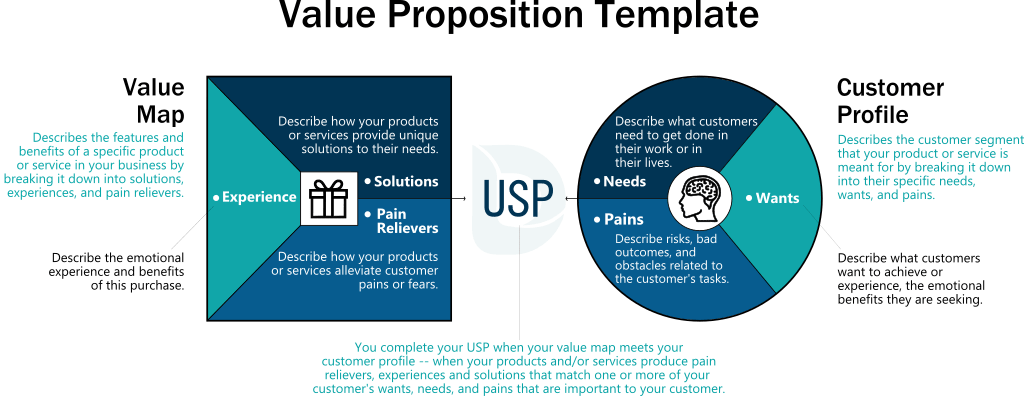WEBINAR: Growth AI Trends and Strategies for RevOps in the AI/ML Era | Wednesday, April 23rd | 1PM ET
Register

Defining and creating a comprehensive customer value proposition strategy is a crucial step in creating an efficient and successful marketing and sales plan.
Your customer value proposition answers the most important question buyers have: why should they do business with you?
A B2B customer value proposition (CVP) communicates the unique benefits that a customer will experience when they choose your products or services to solve their problems. In other words, figuring out what customers really want and need rather than the features of your product or service offerings.

Consulting firm Bain & Company broke down what customers need into five categories using a pyramid structure to determine how to define and meet customer needs. The further you can get up the pyramid, the better your customer value proposition strategy will be. We’ll start at the bottom and work our way up. You’ll see how each layer builds on the previous layer.
Most marketing and sales teams stop after the first three levels, but there’s real power in the top two levels of the pyramid. When you can address the individual and inspirational value as well, good things can happen.
The higher up you can get on the pyramid, the more effective your customer value proposition strategy will be.
Crafting a B2B customer value proposition strategy helps better position your products or strategies. To do so, follow these steps.
The first step in any successful marketing campaign is to understand your target customer. It’s no different when creating a customer value proposition strategy. You need to understand your customer’s expectations and motivations.
Depending on the market you are targeting, your value proposition will need to be customized. This is even more important when you’re targeting specific B2B buyers. For example, an operations manager will have a different perspective than a company’s CFO. The Ops manager wants to know how your product or service will improve a team’s efficiency and workflow, while the CFO is likely more interested in reducing labor cost or increasing output.
There’s an adage in sales: find the pain, ease the pain. It’s the essence of crafting a strong CVP. Invest the time it takes to gain a firm understanding of a company’s problems before suggesting products.
This helps position your team as solution providers rather than sellers, which is key to building long-term relationships.
Most B2B customers these days are facing a set of common problems. They’re concerned about digital transformation and product differentiation, seeing increasing pressure on margins, and worried about ROI for any new expenditures. When you position your CVP, you must acknowledge these problems and show how your product or service provides a solution.
The better you know your customer (step one), the more accurately you will be able to position your CVP to address their specific problems.
Much of B2B selling revolves around risk mitigation for your customers. By providing proof that your solutions work, you can help reduce the risk and build trust.
As B2B customers move through the buyer’s journey, they need increasing proof to help justify a buying decision. Create specific value propositions that demonstrate qualitative and quantitative benefits. For example, qualitative benefits might show how your product streamlines workflow and speeds up delivery. Quantitative benefits would provide numbers showing how companies reduced headcount or labor costs using your product.
Demonstrating that others have successfully implemented your solution and received the results you promised helps mitigate risk.
Make sure you also have an understanding of the benefits and features your competitors are offering. One question you will need to answer is why someone should do business with you rather than another company.
Being able to articulate your point of difference and why your products or services are a better choice is essential to creating a strong customer value proposition.
When creating your value proposition, it helps to visualize it using what’s called the value proposition canvas. The value proposition canvas is divided into two parts, one represented as a square and the other as a circle. The two are interrelated.
In the circle, you have the customer profile, including:
The square contains the value map where you define how you will approach each of these customer profile items:
Another way to approach the CVP development process is to use the framework developed by the IT Service Marketing Association (ITSMA). ITSMA recommends asking these questions each time as you develop your CVP for your customers:
As you hone your CVP, you should be able to answer these questions and demonstrate a succinct value realization message to help your customer understand exactly what they get from your product or service.
In many organizations, there’s still a significant gap between sales and marketing teams. Yet, the benefits of aligning the efforts are undeniable.
A study by the Aberdeen Group showed that aligning sales and marketing produces 38% higher win rates, generates 32% higher revenue, and retains 36% more customers.
As part of your customer value management strategy, make sure everyone is on the same page when it comes to delivering value to your B2B customers. Ensure sales teams have the marketing materials they need and work hand-in-hand when developing lead profiles.
Follow these seven steps and you’ll be on your way to creating a better B2B customer value proposition strategy.
At Xfactor.io, we help companies establish and communicate the economic value of your solutions at every stage of the customer journey. Contact Xfactor.io today to learn more about how we attract > engage > convert > retain and grow customers for life.
Xfactor.io is the GrowthAI platform built for executives who refuse to rely on guesswork. We empower sales, marketing, and operations teams to engineer revenue outcomes with data-driven execution. By unifying strategy, execution, and real-time intelligence, Xfactor.io enables businesses to drive profitable growth, maximize deal value, and close more business—eliminating inefficiencies and replacing guesswork with growth.